Daniel Paternain
Few-shot multi-token DreamBooth with LoRa for style-consistent character generation
Oct 10, 2025Abstract:The audiovisual industry is undergoing a profound transformation as it is integrating AI developments not only to automate routine tasks but also to inspire new forms of art. This paper addresses the problem of producing a virtually unlimited number of novel characters that preserve the artistic style and shared visual traits of a small set of human-designed reference characters, thus broadening creative possibilities in animation, gaming, and related domains. Our solution builds upon DreamBooth, a well-established fine-tuning technique for text-to-image diffusion models, and adapts it to tackle two core challenges: capturing intricate character details beyond textual prompts and the few-shot nature of the training data. To achieve this, we propose a multi-token strategy, using clustering to assign separate tokens to individual characters and their collective style, combined with LoRA-based parameter-efficient fine-tuning. By removing the class-specific regularization set and introducing random tokens and embeddings during generation, our approach allows for unlimited character creation while preserving the learned style. We evaluate our method on five small specialized datasets, comparing it to relevant baselines using both quantitative metrics and a human evaluation study. Our results demonstrate that our approach produces high-quality, diverse characters while preserving the distinctive aesthetic features of the reference characters, with human evaluation further reinforcing its effectiveness and highlighting the potential of our method.
Biased Heritage: How Datasets Shape Models in Facial Expression Recognition
Mar 05, 2025Abstract:In recent years, the rapid development of artificial intelligence (AI) systems has raised concerns about our ability to ensure their fairness, that is, how to avoid discrimination based on protected characteristics such as gender, race, or age. While algorithmic fairness is well-studied in simple binary classification tasks on tabular data, its application to complex, real-world scenarios-such as Facial Expression Recognition (FER)-remains underexplored. FER presents unique challenges: it is inherently multiclass, and biases emerge across intersecting demographic variables, each potentially comprising multiple protected groups. We present a comprehensive framework to analyze bias propagation from datasets to trained models in image-based FER systems, while introducing new bias metrics specifically designed for multiclass problems with multiple demographic groups. Our methodology studies bias propagation by (1) inducing controlled biases in FER datasets, (2) training models on these biased datasets, and (3) analyzing the correlation between dataset bias metrics and model fairness notions. Our findings reveal that stereotypical biases propagate more strongly to model predictions than representational biases, suggesting that preventing emotion-specific demographic patterns should be prioritized over general demographic balance in FER datasets. Additionally, we observe that biased datasets lead to reduced model accuracy, challenging the assumed fairness-accuracy trade-off.
Less can be more: representational vs. stereotypical gender bias in facial expression recognition
Jun 25, 2024Abstract:Machine learning models can inherit biases from their training data, leading to discriminatory or inaccurate predictions. This is particularly concerning with the increasing use of large, unsupervised datasets for training foundational models. Traditionally, demographic biases within these datasets have not been well-understood, limiting our ability to understand how they propagate to the models themselves. To address this issue, this paper investigates the propagation of demographic biases from datasets into machine learning models. We focus on the gender demographic component, analyzing two types of bias: representational and stereotypical. For our analysis, we consider the domain of facial expression recognition (FER), a field known to exhibit biases in most popular datasets. We use Affectnet, one of the largest FER datasets, as our baseline for carefully designing and generating subsets that incorporate varying strengths of both representational and stereotypical bias. Subsequently, we train several models on these biased subsets, evaluating their performance on a common test set to assess the propagation of bias into the models' predictions. Our results show that representational bias has a weaker impact than expected. Models exhibit a good generalization ability even in the absence of one gender in the training dataset. Conversely, stereotypical bias has a significantly stronger impact, primarily concentrated on the biased class, although it can also influence predictions for unbiased classes. These results highlight the need for a bias analysis that differentiates between types of bias, which is crucial for the development of effective bias mitigation strategies.
DSAP: Analyzing Bias Through Demographic Comparison of Datasets
Dec 22, 2023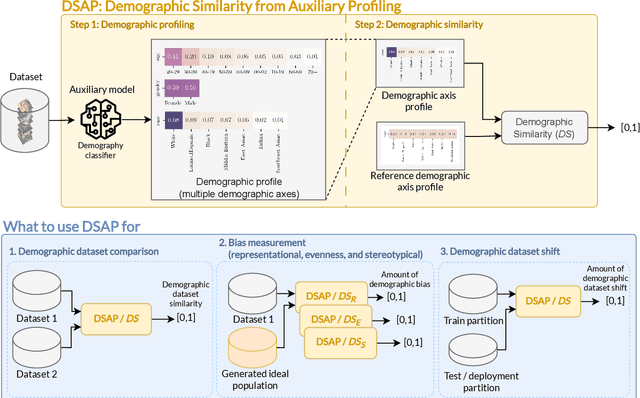
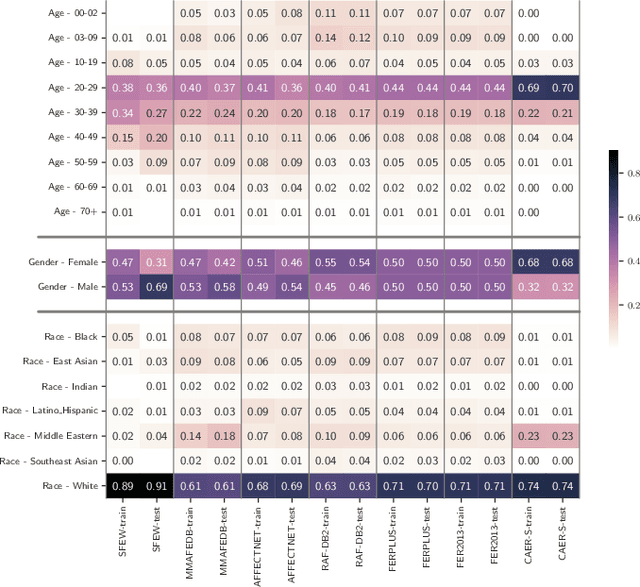
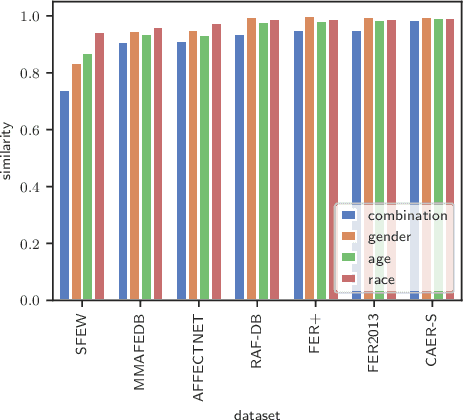
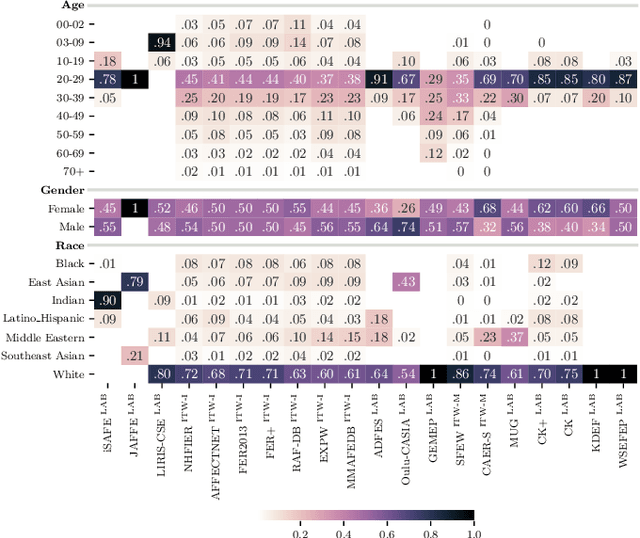
Abstract:In the last few years, Artificial Intelligence systems have become increasingly widespread. Unfortunately, these systems can share many biases with human decision-making, including demographic biases. Often, these biases can be traced back to the data used for training, where large uncurated datasets have become the norm. Despite our knowledge of these biases, we still lack general tools to detect and quantify them, as well as to compare the biases in different datasets. Thus, in this work, we propose DSAP (Demographic Similarity from Auxiliary Profiles), a two-step methodology for comparing the demographic composition of two datasets. DSAP can be deployed in three key applications: to detect and characterize demographic blind spots and bias issues across datasets, to measure dataset demographic bias in single datasets, and to measure dataset demographic shift in deployment scenarios. An essential feature of DSAP is its ability to robustly analyze datasets without explicit demographic labels, offering simplicity and interpretability for a wide range of situations. To show the usefulness of the proposed methodology, we consider the Facial Expression Recognition task, where demographic bias has previously been found. The three applications are studied over a set of twenty datasets with varying properties. The code is available at https://github.com/irisdominguez/DSAP.
Metrics for Dataset Demographic Bias: A Case Study on Facial Expression Recognition
Mar 28, 2023
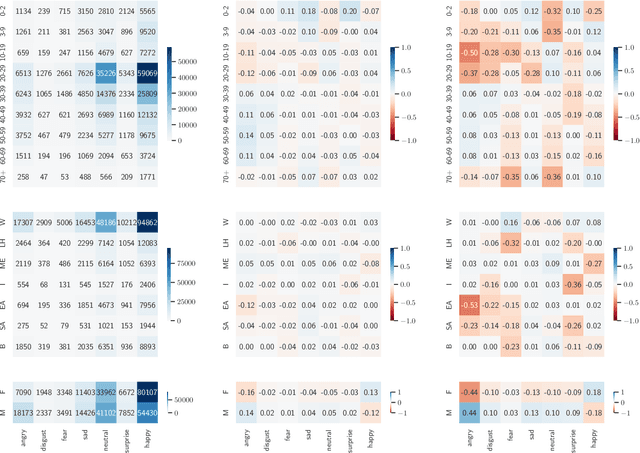
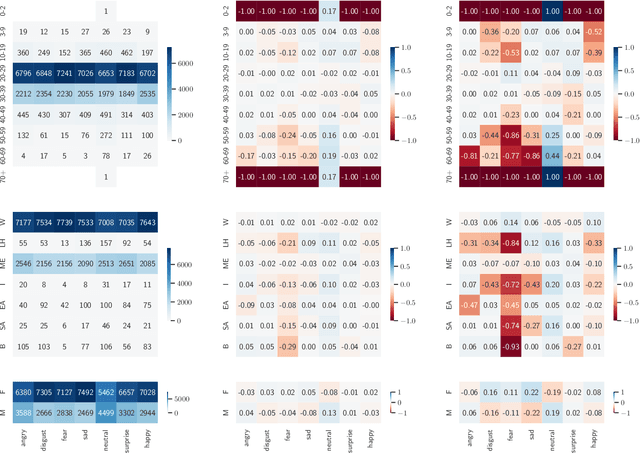
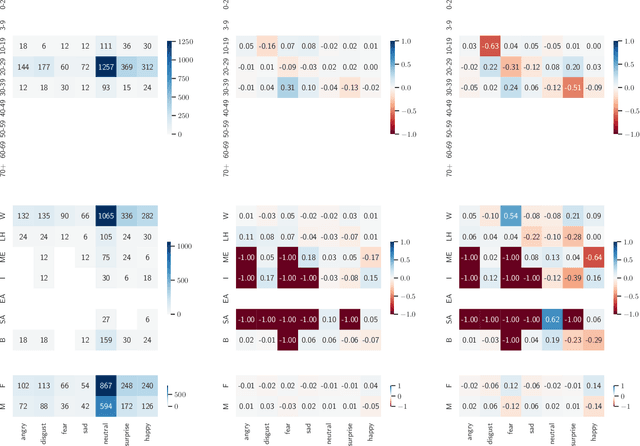
Abstract:Demographic biases in source datasets have been shown as one of the causes of unfairness and discrimination in the predictions of Machine Learning models. One of the most prominent types of demographic bias are statistical imbalances in the representation of demographic groups in the datasets. In this paper, we study the measurement of these biases by reviewing the existing metrics, including those that can be borrowed from other disciplines. We develop a taxonomy for the classification of these metrics, providing a practical guide for the selection of appropriate metrics. To illustrate the utility of our framework, and to further understand the practical characteristics of the metrics, we conduct a case study of 20 datasets used in Facial Emotion Recognition (FER), analyzing the biases present in them. Our experimental results show that many metrics are redundant and that a reduced subset of metrics may be sufficient to measure the amount of demographic bias. The paper provides valuable insights for researchers in AI and related fields to mitigate dataset bias and improve the fairness and accuracy of AI models. The code is available at https://github.com/irisdominguez/dataset_bias_metrics.
Gender Stereotyping Impact in Facial Expression Recognition
Oct 11, 2022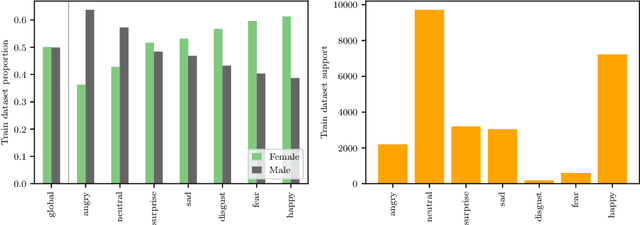
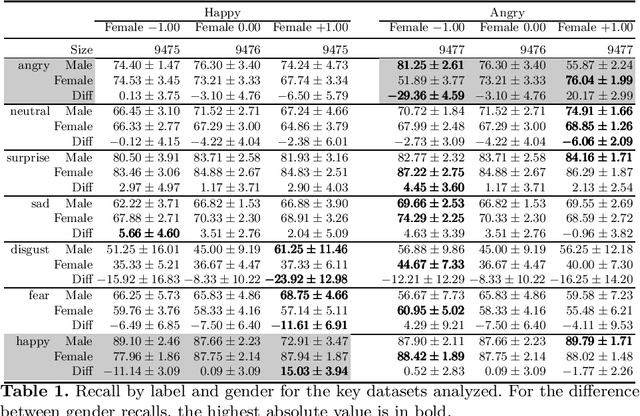
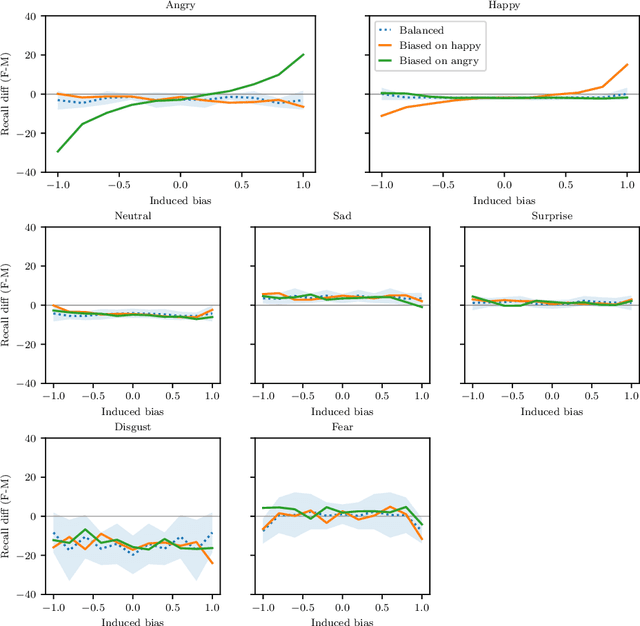
Abstract:Facial Expression Recognition (FER) uses images of faces to identify the emotional state of users, allowing for a closer interaction between humans and autonomous systems. Unfortunately, as the images naturally integrate some demographic information, such as apparent age, gender, and race of the subject, these systems are prone to demographic bias issues. In recent years, machine learning-based models have become the most popular approach to FER. These models require training on large datasets of facial expression images, and their generalization capabilities are strongly related to the characteristics of the dataset. In publicly available FER datasets, apparent gender representation is usually mostly balanced, but their representation in the individual label is not, embedding social stereotypes into the datasets and generating a potential for harm. Although this type of bias has been overlooked so far, it is important to understand the impact it may have in the context of FER. To do so, we use a popular FER dataset, FER+, to generate derivative datasets with different amounts of stereotypical bias by altering the gender proportions of certain labels. We then proceed to measure the discrepancy between the performance of the models trained on these datasets for the apparent gender groups. We observe a discrepancy in the recognition of certain emotions between genders of up to $29 \%$ under the worst bias conditions. Our results also suggest a safety range for stereotypical bias in a dataset that does not appear to produce stereotypical bias in the resulting model. Our findings support the need for a thorough bias analysis of public datasets in problems like FER, where a global balance of demographic representation can still hide other types of bias that harm certain demographic groups.
Assessing Demographic Bias Transfer from Dataset to Model: A Case Study in Facial Expression Recognition
May 20, 2022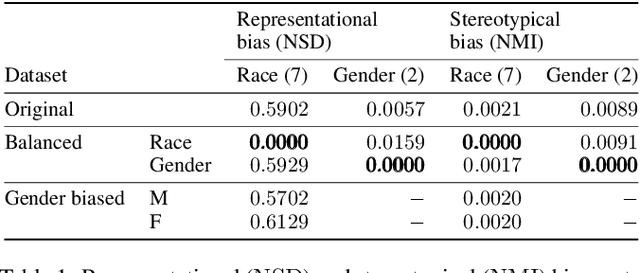
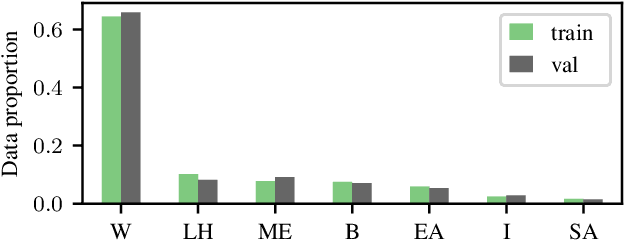
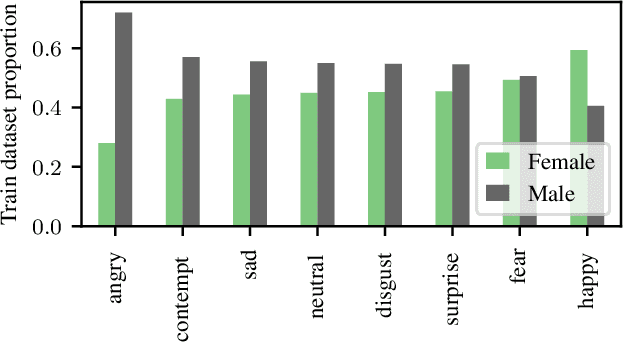
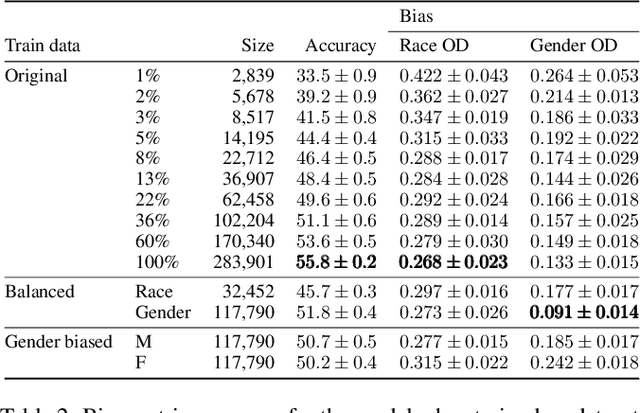
Abstract:The increasing amount of applications of Artificial Intelligence (AI) has led researchers to study the social impact of these technologies and evaluate their fairness. Unfortunately, current fairness metrics are hard to apply in multi-class multi-demographic classification problems, such as Facial Expression Recognition (FER). We propose a new set of metrics to approach these problems. Of the three metrics proposed, two focus on the representational and stereotypical bias of the dataset, and the third one on the residual bias of the trained model. These metrics combined can potentially be used to study and compare diverse bias mitigation methods. We demonstrate the usefulness of the metrics by applying them to a FER problem based on the popular Affectnet dataset. Like many other datasets for FER, Affectnet is a large Internet-sourced dataset with 291,651 labeled images. Obtaining images from the Internet raises some concerns over the fairness of any system trained on this data and its ability to generalize properly to diverse populations. We first analyze the dataset and some variants, finding substantial racial bias and gender stereotypes. We then extract several subsets with different demographic properties and train a model on each one, observing the amount of residual bias in the different setups. We also provide a second analysis on a different dataset, FER+.
 Add to Chrome
Add to Chrome Add to Firefox
Add to Firefox Add to Edge
Add to Edge